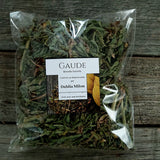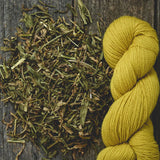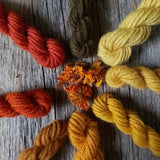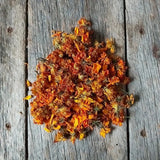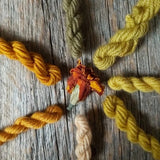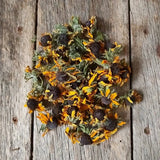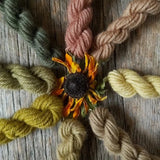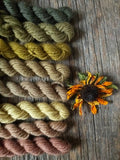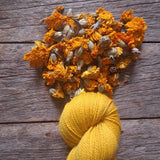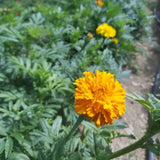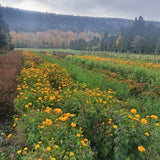Dye Flowers - Dahlia Milon
Dahlia Milon Textile is an artisanal textile maker specializing in vegetable dyeing as well as a gardener who grows dye plants. In the preparation of her dyes, they mainly use plants from their dye plant garden as well as from the harvest of wild plants from Kamouraska area where their studio is located.
Selection of dye plants grown without chemicals in Dahlia Milon's garden in Kamouraska. The plants are packaged in a transparent bag and contain instructions for use (percentage to use, water temperature and cooking details).
You must mordant your own projects.
See mordant kits!
Choose your flowers:
Sulfur Cosmos (Cosmos sulphureus)
The flowers are carefully harvested by hand every day and dried in a dry place out of the sun.
Originally from Central America, it was used for painting as well as dyeing animal fibers by the Aztecs before the Spanish conquest. It produces beautiful, vibrant, rich yellows and oranges. The recommended proportions are: between 30 to 50% of the weight of dry fibers. Alum mordanting is necessary for protein fibers (wool and silk). This flower offers the possibility of creating several color variations using modifiers (iron, copper, acid, etc.). And it is very interesting to use in eco-printing. It is suitable for all natural textiles. And it makes it possible to obtain lacquers and inks for fine arts.
African Marigold (Tagetes erecta)
Native to tropical regions of America, it can be used as an edible flower. In permaculture, it is used as a companion plant to ward off predatory insects. We also find its use during various ceremonies and celebrations in America as well as in India. They are also known as Indian Rose. They produce magnificent mango yellows and olive greens (with iron). Recommended proportions: between 30 to 50% of the weight of dry fibers. Alum mordanting is necessary for protein fibers (wool and silk). Ability to create several color variations using modifiers (iron, copper, acid, etc.).
Very interesting to use in eco-printing and in dye baths or to make your own pigment.
French Marigold (Tagetes patula)
The flowers are carefully harvested by hand every day and dried in a dry place out of the sun. Native to tropical regions of America, it can be used as an edible flower. In permaculture, it is used as a companion plant to ward off predatory insects. We also find its use during various ceremonies and celebrations in America as well as in India. Marigold produces magnificent yellows, golden bronze, moss green and olive green. Recommended proportions: between 30 to 50% of the weight of dry fibers. Alum mordanting is necessary for protein fibers (wool and silk). Ability to create several color variations using modifiers (iron, copper, acid, etc.). Very interesting to use in botanical printing (Eco-print).
Black-eyed Susan (Rudbeckia Hirta)
The flowers are carefully harvested by hand every day and dried in a dry place out of the sun.
Originally from Central America, it is used for fine arts as well as for dyeing. It produces beautiful vibrant greens and pink with citric acid. The recommended proportions are: between 50 to 100% of the weight of dry fibers. Alum mordanting is necessary for protein fibers (wool and silk). It is possible to create several variations of green using modifiers (iron, copper, chalk, etc.). This plant makes it possible to obtain lacquers and inks for fine arts.
Dyer's Weed (Reseda Luteola)
The whole plant is used to make the dye except the roots. Their dyer's weed is carefully harvested, dried and cut by hand.
This plant has been used since the Middle Ages to create colors that are extremely resistant to light and washing. Use 75% of fiber weight for a dark shade. Produces colours from pale yellow to bright lemon yellow depending on the concentration of the dye bath. If used with iron sulfate, will produces khaki green. Use with indigo to create greens, from lime to emerald!
Mordanting with alum is necessary for protein fibers (wool and silk). For cellulosic fibers (cotton, linen, hemp, etc.) it will be necessary to prepare the fiber using a chosen technique (e.g. a tannin bath and two alum baths) before making the dye bath.
















